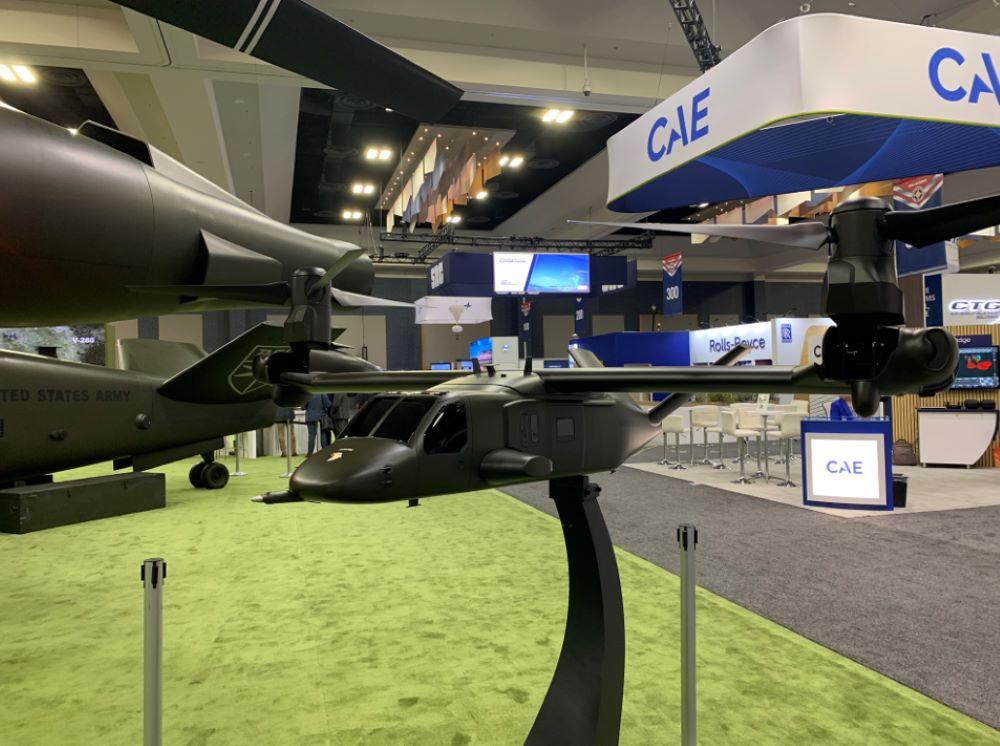
An updated model of Bell’s Future Long Range Assault Aircraft on display April 26.
AURORA, Colorado—An updated model of the Bell V-280 displayed at the U.S. Army’s largest aviation conference here shows that the Future Long Range Assault Aircraft (FLRAA) design is evolving from the demonstrator that won the competition.
The updated model shows significant changes to the outer mold line, including some changes that the Army has publicly directed, such as raised sliding cabin doors with fewer windows. The model shows a refueling probe, something needed for a special operations variant, along with an extended nose, a single central windshield frame and no downward-view window—a feature that the Army has in its Sikorsky UH-60s.
The fuselage sports a revised wing fairing shape and a deeper gear sponson, and the V-tail appears shorter. The engine nacelles are significantly different than the joint multirole technology demonstrator model, with a differently shaped side inlet, and a flatter spinner with reduced height when the prop-rotor is tilted upright.
Bell would not comment directly on the changes to the outer mold line.
Frank Lazzara, Bell’s director of business development for future vertical lift, told Aerospace DAILY at the Army Aviation Association of America’s annual summit here that since winning the FLRAA decision in December 2023, the company is “hyper focused on execution.” This includes zeroing in on model-based systems engineering of the aircraft, signing contracts with suppliers and bringing in Army feedback as it progresses through the final stages of design.
“It’s just, I don’t want to say it’s boring, but it is execution,” Lazzara says.
Bell will conduct initial FLRAA assembly at its Amarillo, Texas, facility while the company looks across its enterprise for where future production will occur.
While the V-280 design is significantly different than Bell’s V-22 that it builds jointly with Boeing, there are lessons being learned from the Osprey. This most notably includes keeping the engines stationary on the V-280 wing, whereas the entire engines tilt on the Osprey. Lazzara says Bell looked to address maintenance and reliability issues from the V-22 on the newer design.
Within the past couple years, an ongoing issue with the V-22’s prop-rotor gearbox has come to the forefront. Specifically, hard-clutch engagements have caused mishaps and sparked a redesign process in the long-term. In the short-term, the military services are replacing the gearbox’s input quill assemblies every 800 hr.
When the hard-clutch engagement issue received attention following high-profile mishaps—and both Bell Boeing and Naval Air Systems Command conducted an analysis—the Army came to the company and requested a brief on the issue. Lazzara says the government wanted to see how the V-280 is different.
“The way the clutch is used on the Future Long Range Assault Aircraft is more conventional, like rotary wing aircraft uses,” he says. “And that design is different than it was on the V-22, not because of what we learned on V-22, but from the beginning, it’s a different design.”
While not going in-depth into the differences, Lazzara says that from the outset the focus on the V-280 was for the simplest, “most conventional way to do it.”
The U.S. Army now plans to have its first units equipped with the new aircraft in 2031, a delay of one year that is attributed to the protest filed by Sikorsky following the award, Maj. Gen. Walter Rugen, the director of Army aviation, said April 25. The service plans its first “limited user test” in 2027-2028.
With Graham Warwick from Washington





